INCA: Interactive Context-aware System for Energy Efficient Living



The aim of this project is to develop an interactive context-aware sensor-based feedback and control system to support energy efficient housing. The system is intended to self-motivate inhabitants to be aware of their energy consumption habits and to be able to decrease energy costs. A network of sensors will be installed into environment to perceive the state of the environment and human actions to be able build models to recognize different human and environment contexts related to electricity and water consumption of different devices. A system with context recognition capabilities will be utilized to give real-time feedback to a user. In addition, the usage of devices and energy consumption is collected from longer periods to build average statistics, which is utilized to detect anomalies in the consumption habits, more precisely, in the energy costs (monetary and social costs: CO2 emission, saving natural resources, etc.), in different categories such as personal profiles, device profiles and groups, and different parts of the house. Besides context recognition, different human computer interaction (HCI) techniques will be studied to build smooth feedback and control system through persuasive interface.
The structure of the system is shown below. A home environment is equipped with different sensors. Inside the system, “modeling” and “database” solutions ensures that the processed information is flawless and meaningful. The processed high-level information will be delivered to the user. The user interface gives feedback and ability to perform control commands in real-time and long-time feedback modes. The controllability of a device will be changed based on the user’s level of awareness in order to support developing an applied skill of energy efficient life, rather than automatic optimization of energy consumption.

This two year project (1.1.2011-31.12.2012) is conducted by two international parties: Intelligent Systems Group (ISG) of University of Oulu led by Prof. Juha Röning and Daily Life Computing Laboratory (DLCL) of Tokyo University of Agriculture and Technology led by Assoc. Prof. Kaori Fujinami with the support by Academy of Finland and Japan Society for the Promotion of Science (JSPS).
Sub Projects:
Project Overview:
Water Consuming Activity Recognition for Encouragement to Restrain Water Waste (TUAT)
In water-tap related activities like dishwashing or hand washing, the users often leave the water flows when brushing or attaching a detergent, which is regarded as "wastes”. More generally, we define wasteful water usage as a situation where water flow is left beside the original water consuming intention.
This subproject aims to investigate a method for recognizing wasteful activities. The information about the type of wasteful activity as well as the duration is utilized to increase the awareness of waste by providing an appropriate feedback. Currently, five types of "wastes" are supported: face washing (C1-9 in the right figure), tooth brushing (C2-9), hand washing (C3-9), dish washing (C4-9), and mere water flow (C9). A three-layer decision tree for water-use activity classification is adopted to detect the five types of wastes in an effective manner. Primarily, we utilize a microphone as a sensor.


Water Consumption Meter based on Mechanical Vibration Sound and Machine Learning techniques (University of Oulu)
In the INCA project, we are developing easy-to-install, low-cost water consumption meter, which could be installed on the existing house without any permanent changes in infrastructure. The water flow is estimated from the mechanical vibration of water pipe. Contact microphone is used to be able to eliminate background noise and environmental sounds.
The water flow estimation is performed using machine learning algorithms based on statistical regression. A supervised training and calibration set is collected using a commercial flow meter. After a short calibration period, our meter can estimate water flow and consumption only using the mechanical vibration of water pipe, where different frequency characteristics of water flow sound together with the K-nearest neighbor and Bayesian kernel regression models are applied. In addition, an embedded system is developed to process incoming data. In the future, the consumption meter can be applied to monitor the water usage of household.


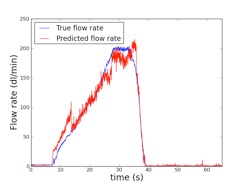
PerFridge: Persuasive Feedback System for Motivating to Conserve Energy on the Refrigerator (TUAT)
Household appliances such as refrigerators and televisions have come into high-functionality in recent years. The increase of energy consumption concurrently becomes a social issue. This subproject focuses on a domestic refrigerator and intends to develop a feedback system that motivates inhabitants to conserve energy. Specifically, we investigate a method of detecting wasteful activities and an effective feedback strategy.
We tentatively defined three types of waste; 1) opening a door without doing anything, 2) putting high-temperature objects, 3) filling up the fridge with so many objects. Heterogeneous sensors are attached in a fridge to recognize these wasteful activities. For instance, a magnetic sensor is utilized to detect opening/closing of a door, and an Infra-red distance sensor recognizes whether a user’s hand is inside or not. Also, a prototype persuasive feedback was implemented. A nature extinction metaphor was adopted in order to embed entertaining functionality and to let a user be familiar with the system. In addition to such an implicit feedback, a user can explicitly obtain detailed information about “waste records” of the past, e.g. a history chart, by tapping an icon.
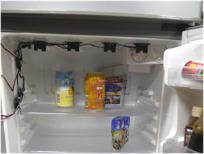
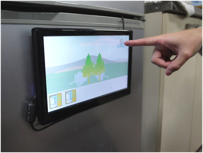
Non-Intrusive Appliance Load Monitoring (University of Oulu)
It is possible to estimate per appliance energy consumption using single sensor installed at the main electrical panel or using power companies smart meter if available. This can be done by noticing the changes in power consumption when appliances turn on or off. These changes are unique to each appliance so it is possible to determine which appliance caused the change. This way we can estimate the operating time of each appliance and therefore approximate the amount of energy used by the appliance.
In the INCA project we have used sensors that are plugged in electrical sockets to develop the load disaggregation algorithm. This kind of sensor can be used to demonstrate the possibilities of this approach but it is not possible to measure a whole household with this sensor. The same algorithm could later be used with data from apartments smart meter so a whole household could be measured and total energy consumption could be divided between different appliances or appliance groups. This would allow giving users more accurate feedback on electricity consumption habits to motivate them saving energy.
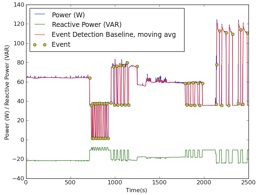
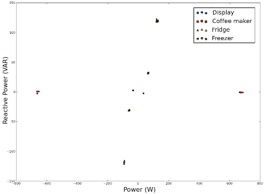
Personal IR Remote Control for Personalized Power Saving of Appliance (TUAT)
Many appliances at homes and offices, e.g. TVs, illuminations, can be operated with individual IR remote controls. This subproject aims to replace such an individual one with a single controller running on a user’s mobile phone. The utilization of a personal belonging allows a system to identify a user of an electrical appliance in an implicit manner. We hypothesize that providing a personalized feedback is more persuasive and effective for power-saving than non-personalized unified feedback. The amount and the duration of power consumption, electric cost, CO2 emission, etc. can be provided per user.
The core component is an Ethernet-IR transmitter gateway that accepts commands from a mobile phone over Ethernet and forwards them to a target IR-controllable device. The system is also utilized to control a device automatically, which allows us to compare various styles of controlling methods, i.e. automatic, semi-automatic and manual ones, in terms of persuasiveness.
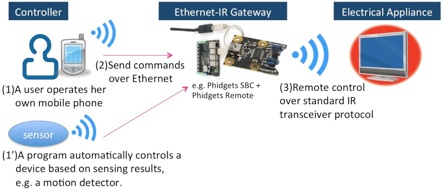
ILCom: INCA Lightweight Communication-ware (TUAT)
To encourage rapid integration of sensing and feedback/control modules developed in the other sub-projects, we are investigating a middleware named ILCom. As the name suggests, it is a lightweight middleware that encapsulates the communication details between distributed components.
ILCom consists of three components: Sender, Receiver, Message Router (MR) and DB. Sender and Receiver acts as a client and a server, respectively. MR performs like a name server that resolves the IP and the port number by a user friendly name, and it is therefore the core of ILCom. Finally, DB manages INCA specific information, e.g. water and electricity usage logs and user profiles. Currently, a set of Java APIs are provided for Sender and Receiver including DB. However, components implemented on other platforms or by languages can communicate each other if they conform with the message specification of ILCom since it is “lightweight”. Even a hand-made device on Arduino platform can communicate with a component running on an Android-based mobile phone.
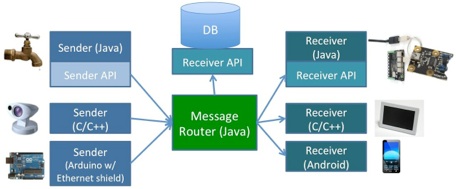

Copyright (C) 2011-2012 INCA project. All Rights Reserved.
Tokyo University of Agriculture and Technology

